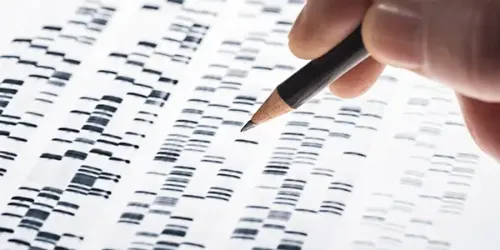Hemochromatosis
"It is a hereditary disease so it is recommended that family members be tested".
DR. DELIA D'AVOLA
SPECIALIST. HEPATOLOGY UNIT

Hemochromatosis is a hereditary disease of iron metabolism that produces an absorption of iron in the digestive tract higher than the daily losses of the body. This causes an excessive deposit of iron in the body.
There are other situations in which there is an increase in iron deposits, such as in hemolytic anemias, iron administration or some liver diseases such as hepatitis C and alcoholic liver disease.
If the disease is diagnosed when there are still no complications and treatment is established early, the prognosis is very good and patients can lead a normal life and their life expectancy is equal to that of healthy individuals.
Otherwise, if at the time of diagnosis there is cirrhosis, diabetes, hepatocarcinoma or heart failure, the prognosis of the patients will depend on these complications.

What are the symptoms of hemochromatosis?
Excessive iron deposition in different organs can lead to chronic diseases. The first clinical manifestations usually occur between the ages of 40 and 60. In women, the onset of symptoms is usually later, because blood loss from menstruation results in periodic iron loss.
Depending on the organ affected, the development of symptoms and diseases varies:
- In the liver, which is the most frequently affected organ, excess iron can cause cirrhosis and the development of liver tumors (hepatocarcinoma).
- In the skin, tanning pigmentation occurs in most patients.
The deposit of iron in the pancreas causes diabetes.- In the joints there is a progressive osteoarthritis, in which acute outbreaks can occur (chondrocalcinosis or pseudogout). In addition, patients with hemochromatosis are at high risk of osteoporosis.
- The deposit of iron in the heart can trigger congestive heart failure and heart arrhythmias.
- Affection of the hypothalamus and pituitary gland can lead to various endocrine manifestations, primarily hypogonadism and hypothyroidism.
What diseases does it cause?
- Liver cirrhosis.
- Diabetes mellitus.
- Heart failure.
- Hepatocarcinoma.
Do you have any of these symptoms?
You may have hemochromatosis
What are the causes of hemochromatosis?
Virtually all patients with hemochromatosis have a mutation in a gene located on chromosome 6, called FSH.
The mutation most frequently associated with the disease is called C282Y, which is present in 90% of people with hemochromatosis. The disease is recessive, so people with hemochromatosis are usually homozygous for the C282Y mutation, that is, the mutation must be on both chromosomes 6 of the individual (inherited from the father and mother). The expression of the disease for homozygous individuals for the C282Y mutation is variable. According to some studies, only 50% of these people develop the symptoms of the disease and 30% do not have an excessive iron deposit.
There are other, more rare forms of hereditary hemochromatosis such as the mutation called H63D.
Family genetic study of hemochromatosis
This disease affects between 2 and 5 white people per thousand.
It is a hereditary disease so it is recommended that family members be tested.
When a patient is diagnosed with hemochromatosis, relatives should be studied in the first degree because early diagnosis and treatment can prevent advanced damage.
If the patient is homozygous for the C282Y mutation of the HFE gene, the first test that should be performed on relatives is the investigation of this mutation; if the relative is homozygous for it, other studies should be done to check for increased iron deposition.
How is hemochromatosis diagnosed?

For the diagnosis of hemochromatosis, some simple studies can lead to the suspicion of an excessive iron deposit.
If a person with iron overload data is found to be homozygous for the C282Y mutation, the diagnosis of hemochromatosis is established, without further study.
If this genetic alteration is not found, a liver biopsy and measurement of liver iron concentration is required to confirm the diagnosis. MRI can estimate the amount of hepatic iron, assess its distribution in the organ and detect the presence of complications, including hepatocarcinoma.
In the Clinic we have all the necessary tools to diagnose and treat hemochromatosis.
In addition, the interaction between the different specialists of the organs that can be affected by hemochromatosis, allows a global evaluation of the patient with this disease to offer him/her an integrated treatment at the level of the different affected organs.
How is hemochromatosis treated?
The normalization of iron deposits prevents the progression of the disease, provided that treatment is initiated before advanced damage occurs.
This normalization of the deposits is achieved with periodic bleeding.
In patients who do not tolerate bleeding, deferroxiamine can be used, which increases iron removal, but this treatment is less effective.
In patients with advanced liver damage, liver transplantation may be indicated.
Where do we treat it?
IN NAVARRE AND MADRID
The Hepatology Unit
of the Clínica Universidad de Navarra
We are pioneers in the application of gene therapy in the treatment of liver tumors and hereditary metabolic diseases, and we have extensive experience in the diagnosis and treatment of viral hepatitis and in the treatment of liver cancer using radioembolization systems with Ytrium-90 microspheres.
The Clinic is at the forefront in Spain in performing liver transplantation between living people.
Diseases we treat
Treatments we perform
- Hepatic Arterial Embolization
- Partial splenic embolization
- Genetic study in hepatology
- Liver Radiofrequency
- Liver Radioembolization
- Liver resection
- Liver transplantation

Why at the Clinica?
- Highly specialized team of professionals with more than 25 years of experience.
- Nursing team specialized in hepatic patients.
- Important research activity on the molecular mechanisms that cause some of these diseases.









